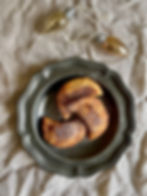Risshewes (Medieval Fruit Pasties)
- sjfbilton
- Dec 16, 2021
- 3 min read
The blog has been taking a back seat this year. I’ve been busy promoting First Catch Your Gingerbread and immersing myself in the middle ages with short forays into ancient Rome and the eighteenth century. I have been researching the culinary history of English saffron which has been incredibly absorbing. It has also yielded gems of recipes like this which I wanted to share with you.
Risshewes are a kind of medieval fruit pasty – think deep fried mince pie (without any meat). This recipe is amalgam of a couple very similar formulas in Two Fifteenth Century Cookery Books.

Yes, I know we not supposed to like deep fried foods but these are soooo good and it is Christmas (although, obviously, they would be superb at any time of the year). But if you really are against fried foods there are instructions for a baked variation at the end of the recipe.
Plus it gives you an idea of the good things to come in June 2022 when my book is released.
Have a fabulous Christmas!
Ingredients
Pastry
30 strands saffron soaked in 2 tbsp hot water then allowed to cool 250g/9oz/2 cups plain flour 3 tbsp icing sugar 125g/4½ oz/½ cup cold unsalted butter cubed 1 egg
Filling
20 strands saffron soaked in 2 tbsp hot water for at least 1 hour 150g/5oz/1 cup dried figs, chopped 50g/2oz/⅓ cup dates, chopped 50g/2oz/½ cup currants 3 tbsp walnut oil or other light, mild flavoured oil 3 tbsp pine nuts 50g/2oz/¼ cup sugar ½ tsp ground cinnamon ½ tsp ground ginger ¼ tsp ground black pepper ¼ tsp ground mace ⅛ tsp ground Cloves ⅛ tsp fine sea salt 1 egg, beaten 1litre/1¾pts/4¼ cups vegetable oil for frying

Method
To make the pastry, sieve the flour and icing sugar into a bowl. Rub in the butter until the mixture resembles breadcrumbs. Add the egg and the 30 strand saffron infusion to bind the pastry (add a little more water if necessary). Alternatively, blitz the flour, icing sugar and butter in a food processor then add the egg and saffron infusion. Form the dough into a ball, cover and refrigerate for at least one hour.
To make the filling, place the 20 strand saffron infusion, dried figs, dates, currants and walnut oil into a small food processor. Blitz until you have a rough paste. If you don’t have a food processor place the dried figs, dates and currants on a board then chop vigorously with a large knife until you have a rough paste (it will seem a little dry at this stage). Transfer to a bowl then add the walnut oil and saffron infusion.
Transfer the paste from the food processor to a small bowl. Add the pine nuts, sugar ground spices and salt. Mix well until thoroughly combined. Divide the fruit paste into 12 piles (roughly 30g each).
On a lightly floured board roll out the saffron pastry to a thickness of 2-3mm. Stamp out 12 rounds using a 14-15cm cutter. You will probably need to re-roll the pastry. Save any off cuts to test the temperature of the oil.
Lightly brush each round with egg. Place one pile of the fruit paste to one side of the circle, leaving 1cm around the top edge of the circle. Shape the paste into a rough semi circle. Lift the bottom half of the dough up and over the paste, enclosing it like a small pasty. Press the edges firmly to ensure the pastry is sealed.
Heat the oil in a large wok over a medium-high heat. To see whether the oil is at an appropriate temperature fry a small piece of the left over pastry. It should result in a spritely but not too ferocious sizzle (approximately 175℃). Fry the pastries in batches, say three or four at a time, for around 4 minutes (if you have a deep fat fryer this time may be reduced). Turn them frequently. When they are done they will be a golden brown colour. Drain on kitchen towel before serving sprinkled with a little icing sugar. These are best eaten warm but can be reheated in a low oven for 5-10 minutes.